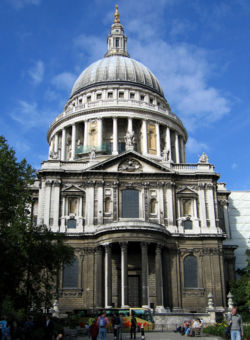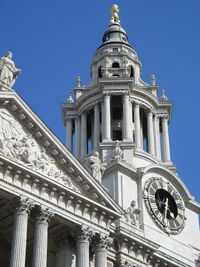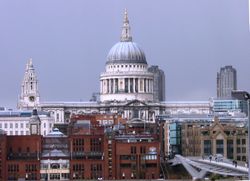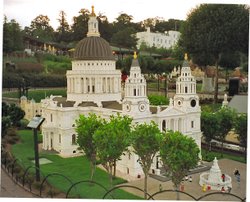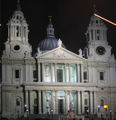St Paul's Cathedral
2007 Schools Wikipedia Selection. Related subjects: Architecture
- Old St Paul's redirects here, for the church in Wellington, New Zealand see Old Saint Paul's
- This article is about the cathedral in London. For other uses of the term, see Cathedral of Saint Paul.
St Paul's Cathedral is a cathedral on Ludgate Hill, in the City of London, England and the seat of the Bishop of London. The present building dates from the 17th century, and is generally reckoned to be London's fifth St Paul's Cathedral, although the number is higher if every major medieval reconstruction is counted as a new cathedral. The cathedral is one of London's most visited sites.
The previous cathedrals
Pre-Norman
- The first, Saxon cathedral was built, in wood, and dedicated to Saint Paul, probably by Mellitus or another of the Augustinian missionaries on the re-foundation (there had been a late-Roman see in the city) of the See of London in AD 604, on Ludgate Hill in the western part of the old Roman city (it was these missionaries' habit, also done on the continent, to build cathedrals within old Roman city-walls) and the eastern part of Lundenwic. This building was traditionally said to be on the site of an ancient megalith, or stone circle. and a temple dedicated to the goddess Diana, in alignment with the Apollo Temple which once stood at Westminster (although Christopher Wren found no evidence of this). Template:Kruger, 1943. This would have only been a modest chapel at first and may well have been destroyed after he was briefly expelled from the city by Saeberht's pagan successors. It burned down in 675.
- The cathedral was rebuilt, in stone, in 685. In it was buried King or Saint Sebbi of Essex. It was sacked by the Vikings in 961 as is cited by the Anglo-Saxon Chronicle.
- The third cathedral was begun in 962, again in stone. In it was buried Ethelred the Unready. It burnt, with the whole city, in a fire of 1087 (in Anglo-Saxon Chronicle).
'Old St Paul's'
|
Old St Paul's Cathedral from the Thames, between 1630 and 1666 |
|||
The fourth St Paul's (known as Old St Paul's, a nineteenth century coinage, or the pre-Great Fire St Paul's), was begun by the Normans after the 1087 fire. Work took over two hundred years, and a great deal was lost in a fire in 1136. Nonetheless the roof was once more built of wood, which was ultimately to doom the building. The church was consecrated in 1240, but a change of heart soon led to the commencement of an enlargement programme in 1256. This 'New Work' was completed in 1314. The cathedral was however consecrated in 1300. It was the third longest church in Europe. Excavations in 1878, by Francis Penrose showed it had been at 585 feet long, 100 feet wide (290 feet across the transepts and crossing), and had one of Europe's tallest spires at some 489 feet (149 metres).
By the 16th century the building was decaying. Under Henry VIII and Edward VI, the Dissolution of the Monasteries and Chantries Acts led to the destruction of interior ornamentation in the cathedral as well as the cloisters, charnels, crypts, chapels, shrines, chantries and various other buildings in the churchyard. Many of these former religious sites in St Paul's Churchyard, having been seized by the crown, were sold as shops and rental properties, especially to printers and booksellers who were often evangelical Protestants. Buildings that were razed often supplied ready-dressed building material for new construction projects, such as the Lord Protector's city palace, Somerset House.
Crowds were drawn to the northeast corner of the Churchyard, St Paul's Cross, where open air preaching took place. It was there in the Cross Yard in 1549 that radical Protestant preachers incited a mob to destroy many of the cathedral's interior decorations. In 1561 the spire was destroyed by lightning and it was not replaced; this event was taken by Protestants and Catholics alike as a sign of God's displeasure of the other faction's actions.
England's first classical architect Sir Inigo Jones added the cathedral's new west front in the 1630s, but there was much defacement and mistreatment of the building by Parliamentarian forces during the English Civil War, when the old documents and charters were dispersed and destroyed (Kelly 2004). "Old St Paul's" was finally gutted in the Great Fire of London of 1666. While it might have been salvageable, albeit with almost complete reconstruction, a decision was taken to build a new cathedral in a modern style instead. Indeed this had been contemplated even before the fire.
Wren's St Paul's
Design and construction
The task of designing a replacement structure was assigned to Christopher Wren in 1668, along with over fifty other City churches. His first design (to build a replacement on the foundations of the old cathedral) was rejected in 1669. The second design, in the shape of a Greek cross (circa 1670- 1672) was rejected as too radical, as was a revised design which resulted in the 1:24 scale "Great Model", currently on display in the crypt of the cathedral. The 'warrant' design was accepted in 1675 and building work began in June. This design included a smaller dome with a spire on top, however King Charles II had given Wren permission to make "ornamental" changes to the approved design, and Wren took the liberty to radically rework the design to the current form, including the large central dome and the towers at the West end. The cathedral was completed on October 20, 1708, Wren's 76th birthday (although the first service was held on December 2, 1697).
- Sir Christopher Wren
- Said, "I am going to dine with some men.
- If anyone calls,
- Say I am designing St Paul's."
- A clerihew by Edmund Clerihew Bentley
- Said, "I am going to dine with some men.
Description
The cathedral is built of Portland stone in a late Renaissance style that is England's sober Baroque. Its impressive dome was inspired by St Peter's Basilica in Rome. It rises 108 metres (365 feet) to the cross at its summit, making it a famous London landmark. Wren achieved a pleasing appearance by actually building three domes: the tall outer dome is non-structural but impressive to view, the lower inner dome provides an artistically balanced interior, and between the two is a structural cone which supports the apex structure and the outer dome panelling. During the building of its later stages, Wren was said to have been hauled up to the rafters in a basket to inspect the progress of the work.
The cathedral is to the east from the Great West Door. The nave has three small chapels in the two adjoining aisles – All Souls and St Dunstan's in the north aisle and the Chapel of the Order of St Michael and St George in the south aisle. The main space of the cathedral is centred under the Dome; it rises 108.4 metres from the cathedral floor and holds three circular galleries – the internal Whispering Gallery, the external Stone Gallery, and the external Golden Gallery.
The Whispering Gallery runs around the interior of the Dome and is 259 steps up from ground-level. It gets its name from a serendipitious quirk of dome construction: a whisper against its wall at any point is audible to a listener with their ear held to the point diametrically opposite.
The Quire extends to the east of the dome and holds the stalls for the clergy and the choir as well as the cathedral's organ. The organ was first commissioned in 1694 and the current instrument is the third biggest in Britain with 7,189 pipes and 138 stops; it is enclosed in an impressive case built by Grinling Gibbons. To the north and south of the dome are the transepts of the North Choir and the South Choir.
The north west tower contains 13 bells, while the south west tower contains 4 bells including Great Paul, which was cast in 1881, and Great Tom (the hour bell), which has been recast twice, after being moved from the old Palace of Westminster.
Post-Wren history
This cathedral has survived until the present day, despite being targeted during the Blitz (it was struck by bombs on October 10, 1940 and April 17, 1941 but survived) On September 12, 1940 a time delayed bomb which had struck the Cathedral was successfully defused and removed by a Bomb Disposal detachment of Royal Engineers under the command of Temporary Lieutenant Robert Davies. Had this bomb detonated it would have totally destroyed the Cathedral, as it left a 100 foot crater when it was later remotely detonated in a secure location. As a result of this action Robert Davies was awarded the George Cross ( Gazetted September 30, 1940). His George Cross and other medals are now on display at the Imperial War Museum, London.
Memorials
The cathedral has a very substantial crypt holding over 200 memorials as well as the Order of the British Empire Chapel and the Treasury (the cathedral has very few treasures: Many have been lost, and in 1810 a major robbery took almost all of the remaining precious artefacts). Christopher Wren was the first person to be interred (in 1723): on the wall above his tomb in the crypt is simply written, "Lector, si monumentum requiris, circumspice" (Reader, if you seek a monument, look around you).
St Paul's is home to other plaques, carvings, statues, memorials and tombs of famous British figures including:
- General Sir Isaac Brock
- Sir Edwin Lutyens
- John Donne, whose funeral effigy (portraying him in a shroud), but not tomb, survives from Old St Paul's.
- Lord Kitchener
- The Duke of Wellington
- Admiral Nelson
- Henry Moore
- Sir Winston Churchill
- T.E. Lawrence whose bust faces Nelson's sarcophagus
- Sir Alexander Fleming
- Sir Arthur Sullivan
- Florence Nightingale
- J.M.W. Turner
- Sir Joshua Reynolds.
Most of the memorials commemorate the British military, including several lists of servicemen who died in action, the most recent being the Gulf War. There are special monuments to Admiral Nelson in the south transept and to the Duke of Wellington in the north aisle; both are buried here. Also remembered are poets, painters, clergy and residents of the local parish. There are also lists of the Bishops and cathedral Deans for the last thousand years.
The cathedral has been the site for many famous funerals, including those of Nelson, Wellington and Winston Churchill.
Modern-day
The British Royal Family hold most of their important marriages, christenings and funerals at Westminster Abbey, but St Paul's was used for the marriage of Charles, Prince of Wales and Lady Diana Spencer.
In 2001, Britain's memorial service to honour the victims of the September 11, 2001 attacks was held at St Paul's Cathedral, which the British Royal Family and then-U.S. ambassador William Farish attended. He spoke, as did Prince Philip. Farish said just before he resigned as ambassador in 2004 in The Times that this service showed the strong relationship between the US and Britain. It also held, on November 1st 2005, a memorial service for the July 7th bombings.
The cathedral is open to the public, though there is a charge for non-worshipping visitors. In 2000, the cathedral began a major restoration programme, scheduled for completion in 2008, to celebrate the 300th anniversary of its opening. A ceremony to celebrate the anniversary was directed by Patrick Garland. The restoration programme is expected to cost £40 million, and involves not only repair and cleaning of the building, but also improvement of visitor facilities - such as accessibility for the disabled, and provision of additional educational facilities.
In popular culture
Because of its prominent and recognizable form on the skyline, a view which is protected from many vantage points, St Paul's is often used in movies as part of an establishing shot to place the viewers in London.
It also features specifically in:
- Mary Poppins, where it is the setting of the song Feed the Birds
- Lawrence of Arabia as the venue of Lawrence's funeral.
- Steamboy, seen in scenes with the cathedral.
- 101 Dalmatians
- Peter Pan
- The War of the Worlds, H.G. Wells
- Team America: World Police
- The Bed-Sitting Room (film version 1970) depicts the post - nuclear wreckage of the dome lying in the middle of a lake.
- The cathedral was prominent in all Thames Television idents from 1968 until 1992 and prominent in its logo until 1997
- The established opening titles of Mr. Bean began with a shot of Mr. Bean falling from the sky with St. Paul's in the background.
- The 1966 Doctor Who story The Invasion where Cybermen emerge and walk towards the Thames outside the cathedral.
- The 1966 film, Georgy Girl. As Joss and Georgy sail down the Thames, there is a captain who points out the house where Christopher Wren lived whilst the dome was being originally constructed. The dome appears in the background and seems to be undergoing some kind of renovation, as the dome is covered in scaffolding.
- The 1971 Hammer Horror film Hands of the Ripper
- The Cathedral became the lair of Giant Black Rats in James Herberts 1993 graphic novel, The City.
- The 1994 film The Madness of King George
- Mortal Engines where it is the house of the super weapon MEDUSA when it is mounted upon the great Traction City of London.
- From Hell - in the graphic novel version by Alan Moore, the cathedral is seen with an ominous look during a cloudy day in the opening panel.
- In the 2005 Doctor Who story The Empty Child, the cathedral can be seen in numerous background shots during the Blitz.
- In the 2006 Doctor Who story Rise of the Cybermen, the cathedral is seen briefly in a background shot as the Doctor and Rose walk through a parallel universe London.
Fire Watch by Connie Willis, a Hugo and Nebula winning short story, is set mostly in and around the cathedral during the final months of 1940, when it was targeted in the Blitz.
The idiom "rob Peter to pay Paul" has a folk etymology of using the funds of Westminster Abbey for the cathedral.
There is a scale model of the cathedral at LEGOLAND Windsor.
